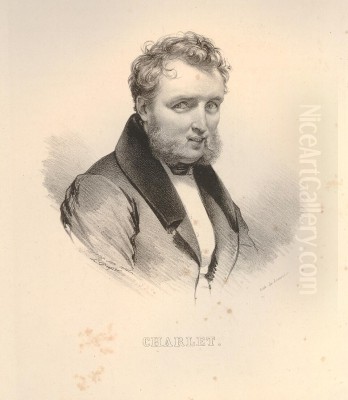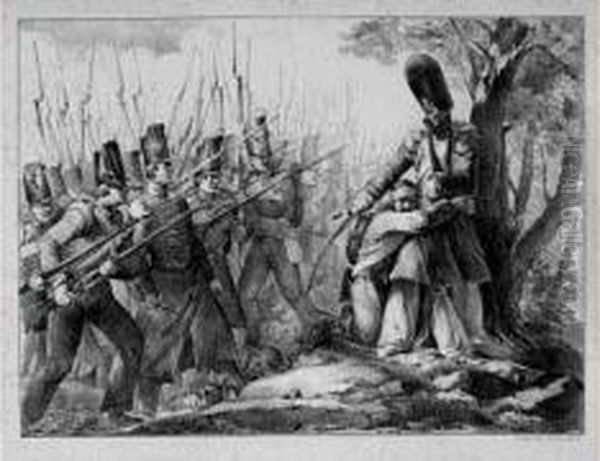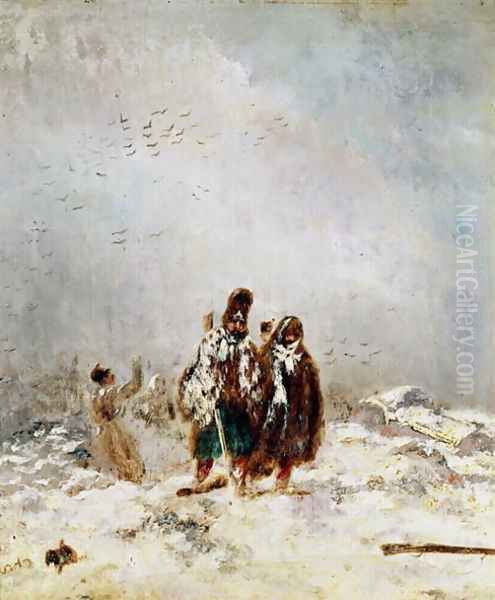
Nicolas Toussaint Charlet stands as a significant figure in early nineteenth-century French art, a period of immense political upheaval and artistic transformation. Born in Paris on December 20, 1792, and passing away in the same city on October 30, 1845, Charlet's life and career were intrinsically linked to the Napoleonic legend and the burgeoning medium of lithography. He was a prolific designer, painter, and, most notably, a lithographer whose works captured the spirit of his time, from the grandeur of military exploits to the intimate, often humorous, scenes of everyday life.
Early Life and Formative Experiences
Charlet's beginnings were marked by hardship. His father, a dragoon in the Republican army, perished on the battlefield, leaving his young son and wife in a state of considerable poverty. This early loss and the family's straitened circumstances undoubtedly shaped Charlet's worldview. Despite these challenges, his mother was determined to provide him with a sound education, a foundation that would later serve his artistic and intellectual development. The patriotic fervor associated with his father's service and the Napoleonic era likely instilled in him a deep-seated admiration for the common soldier.
His early adult life saw him employed in a civilian capacity, working at the Paris city hall where he was tasked with registering new military recruits. This position would have given him firsthand exposure to the men who formed the backbone of France's armies. The call to arms eventually reached Charlet himself; in 1814, as Allied forces closed in on Paris, he joined the National Guard. He participated in the defense of the city, notably fighting at the Barrière de Clichy, an experience that would further cement his connection to military life and its human drama.
However, the fall of Napoleon and the subsequent Bourbon Restoration brought a shift in Charlet's fortunes. His known Bonapartist sympathies and opposition to the restored monarchy led to his dismissal from his administrative post in 1816. This setback, however, proved to be a pivotal moment, redirecting his energies towards a full-time pursuit of art.
Artistic Apprenticeship and the Rise of Lithography

Freed from his municipal duties, Charlet sought formal artistic training. He entered the prestigious studio of Baron Antoine-Jean Gros, one of Jacques-Louis David's most prominent pupils. Gros was himself a celebrated painter of Napoleonic battles and portraits, renowned for works like Napoleon Bonaparte Visiting the Plague-Stricken in Jaffa and Napoleon on the Battlefield of Eylau. Under Gros, Charlet would have honed his drawing skills and absorbed the principles of academic composition, though his temperament leaned more towards the burgeoning Romantic sensibility and the directness of observation.
It was during this period that lithography, a relatively new printing technique invented by Alois Senefelder in Germany in the late 1790s, began to gain traction in France. Introduced to Paris by figures like Godefroy Engelmann, lithography offered artists a more direct and autographic method of printmaking compared to engraving or etching. It allowed for a greater range of tonal effects and a quicker production process, making images more accessible to a wider public. Charlet quickly recognized the potential of this medium.
He embraced lithography with enthusiasm, finding it perfectly suited to his talent for expressive drawing and his desire to disseminate his images broadly. It became his primary medium, and he would go on to produce an astonishing number of lithographs – estimated at around two thousand – throughout his career.
The Napoleonic Legend in Charlet's Art
A significant portion of Charlet's oeuvre is dedicated to the French soldier, particularly the "grognard," the grizzled veteran of Napoleon's Grande Armée. In the years following Waterloo and during the Bourbon Restoration, there was a potent undercurrent of Napoleonic nostalgia. Charlet's lithographs tapped into this sentiment, celebrating the courage, resilience, and camaraderie of the ordinary soldier. He avoided the grand, heroic allegories favored by some academic painters, focusing instead on the human aspect of military life.
One of his most famous early lithographs, often cited as Grenadier de Waterloo (Grenadier of Waterloo) from around 1817, is sometimes associated with the defiant phrase "La Garde meurt et ne se rend pas!" (The Guard dies and does not surrender!). While the exact attribution of this phrase is debated by historians, Charlet's image of a steadfast, battle-worn grenadier perfectly encapsulated this spirit of unyielding loyalty and sacrifice. His soldiers were not idealized classical heroes but recognizable individuals, often depicted with a touch of pathos or rugged humor.

His works frequently portrayed scenes from Napoleon's campaigns, such as his notable oil painting, Episode in the Russian Campaign (1836), also known as The Retreat from Russia, now housed in the Musée de Lyon (though a version is also at Versailles). This painting, and related prints, depicted the harrowing conditions faced by the French army during that disastrous retreat, emphasizing the endurance and suffering of the soldiers. Other works captured moments of camp life, marches, and the aftermath of battle, always with a focus on the common soldier's experience. Artists like Théodore Géricault, with his powerful depictions of cavalrymen such as The Charging Chasseur, shared this Romantic fascination with the dynamism and drama of military life, though Géricault's approach was often more monumental and psychologically intense.
Beyond the Battlefield: Genre Scenes and Social Commentary
While Charlet is best known for his military subjects, his artistic interests were far broader. He produced a vast number of lithographs depicting scenes of everyday French life, encompassing rural and urban settings, and particularly, the world of children. These genre scenes reveal a keen eye for observation, a warm humanity, and a distinct sense of humor, often tinged with gentle satire.
His depictions of children are particularly noteworthy. He captured their boisterous games, their innocent mischief, and their interactions with the adult world. These works often carried a subtle social commentary, contrasting the unpretentious world of children with the sometimes absurd conventions of adult society. For instance, a series might show children mimicking adult behaviors, thereby gently mocking those behaviors.
Charlet's urban scenes often featured street vendors, artisans, and the bustling life of Paris. His rural scenes depicted peasants at work or leisure, reflecting an interest in the traditional ways of life that were beginning to change with industrialization. In this, his work can be seen as part of a broader European trend in genre painting and printmaking, which found an eager audience in the growing middle class. His ability to infuse these everyday subjects with character and narrative made them highly popular. The satirical edge in some of these works aligns him with the spirit of later artists like Honoré Daumier, who would become a master of social and political caricature through lithography.
Artistic Style and Technique
Charlet's style was characterized by its directness, vivacity, and strong draftsmanship. In his lithographs, he demonstrated a masterful command of the medium, using bold lines, rich blacks, and subtle gradations of tone to create lively and expressive images. His compositions were typically clear and uncluttered, focusing attention on the human figures and their interactions. He had a particular talent for capturing characteristic gestures and facial expressions, bringing his subjects to life.
While lithography was his forte, Charlet was also proficient in other media. He produced numerous watercolors, sepia drawings, and oil sketches. These works often display a more fluid and painterly quality, but the underlying strength of his drawing is always evident. His oil paintings, though fewer in number than his prints, demonstrate his ability to handle more complex compositions and color, as seen in Episode in the Russian Campaign.
His approach was less about academic polish and more about capturing the essence of his subject with energy and immediacy. This aligns him with the Romantic movement's emphasis on emotion and individualism, though he generally avoided the more extreme melodrama found in some Romantic art, such as that of his contemporary Eugène Delacroix. Instead, Charlet's Romanticism was tempered by a down-to-earth realism and a sympathetic understanding of human nature.
Contemporaries and Artistic Milieu
Charlet operated within a vibrant and competitive artistic environment in Paris. His teacher, Antoine-Jean Gros, remained an influential figure, though Gros himself struggled to adapt to the changing artistic tastes after the fall of Napoleon, eventually returning to a more classical style influenced by his own master, Jacques-Louis David. David, the towering figure of Neoclassicism, had shaped a generation of artists, including Jean-Auguste-Dominique Ingres, who would become a champion of classical linearity in opposition to the coloristic Romanticism of Delacroix.
Among his contemporaries who also explored military themes were Horace Vernet and Théodore Géricault. Vernet, like Charlet, was incredibly prolific and popular, known for his large-scale battle paintings and his adept use of lithography. While the provided information suggests a "collaboration in Paris," this likely refers to their works being produced and distributed by the same lithographic printing houses, such as those run by Engelmann or Charles Motte, rather than direct artistic co-creation on individual pieces. Géricault, though his career was tragically short, produced iconic military images and was a pioneer of Romanticism.
Charlet's most notable pupil was Denis Auguste Marie Raffet. Raffet closely followed in his master's footsteps, specializing in military subjects and lithography, and achieving considerable fame in his own right. He, too, contributed significantly to the visual culture of the Napoleonic legend and the depiction of French military history.
The tradition of depicting military subjects with meticulous detail would be continued later in the century by artists like Jean-Louis-Ernest Meissonier and Édouard Detaille, who focused on historical accuracy and dramatic narrative in their paintings. While Charlet's work was perhaps less polished in a purely academic sense, its immediacy and emotional resonance set a precedent.
In the realm of genre scenes and social observation, Charlet's work can be compared to that of earlier artists like Louis-Léopold Boilly, who chronicled Parisian life with wit and detail. The tradition of Watteau, particularly the works of the "Watteaus of Lille" (Louis Joseph Watteau and his son François Watteau), who depicted local fêtes and everyday scenes, also provides a context for genre art in France, and it's plausible Charlet may have created prints after their designs or been influenced by their popular appeal.
Personal Life and Character
Accounts from his contemporaries describe Nicolas Toussaint Charlet as a man of cheerful disposition, possessing a lively sense of humor and a kind heart. He was reportedly well-liked by his friends and colleagues. In 1824, he married, and the couple had two sons. His personal warmth and engaging personality likely contributed to his popularity and the accessibility of his art.
Despite his professional success, his later years were clouded by declining health. From around 1838, he began to suffer from a lung ailment, possibly tuberculosis, which was prevalent at the time. This illness progressively weakened him. Nevertheless, he continued to work as much as his health permitted. His contributions to art and culture were recognized; in 1838, he was appointed professor of drawing at the prestigious École Polytechnique, a testament to his standing in the artistic community, and in the same year, he was made a Chevalier of the Legion of Honour.
Later Years, Declining Health, and Death
The final years of Charlet's life were a struggle against his worsening pulmonary condition. The disease gradually sapped his strength, limiting his ability to work with the same prodigious energy that had characterized his earlier career. Despite this, his passion for art and his commitment to his subjects remained.
Nicolas Toussaint Charlet passed away on October 30, 1845, in Paris, the city of his birth and the backdrop for so much of his artistic output. He was only fifty-three years old, his life cut short by illness. His death was mourned by many who admired both the man and his art. He left behind a rich legacy of images that had captured the imagination of a generation.
Legacy and Enduring Influence
Nicolas Toussaint Charlet's impact on French art and visual culture was substantial, particularly through the medium of lithography. He was one of the first artists to fully exploit the democratic potential of this new printmaking technique, creating thousands of images that were affordable and widely circulated. His depictions of the Napoleonic soldier played a crucial role in shaping and perpetuating the Napoleonic legend long after the Emperor's demise. These images resonated deeply with a public that yearned for past glories or sought to understand the human cost of war.
His genre scenes, with their humor and sympathetic portrayal of everyday life, contributed to the popularity of this type of art and offered a valuable record of French society during the early to mid-nineteenth century. He demonstrated that ordinary subjects, when observed with a keen eye and a warm heart, could be just as compelling as grand historical or mythological themes.
His works are preserved in numerous French museums, including the Louvre and the Musée Carnavalet in Paris, as well as in many provincial museums and private collections. Art historians and collectors continue to study his prints for their artistic merit, their historical significance, and their insight into the social and cultural currents of his time. While perhaps not as revolutionary as some of his more famous Romantic contemporaries like Géricault or Delacroix, Charlet carved out a unique and influential niche. He was a master storyteller in visual form, a chronicler of the common man, whether a soldier on the battlefield or a child at play on the streets of Paris.
Conclusion
Nicolas Toussaint Charlet was more than just a skilled draftsman and lithographer; he was a visual historian of his era. His art provides a compelling window into the France of the Napoleonic Wars, the Bourbon Restoration, and the July Monarchy. Through his prolific output, he celebrated the resilience of the French spirit, paid homage to the ordinary soldier, and captured the myriad facets of everyday life with wit and empathy. His mastery of lithography helped to popularize the medium and bring art to a broader audience, leaving an indelible mark on the visual culture of the nineteenth century. His legacy endures in the thousands of images that continue to speak to us of a bygone age, rendered with a humanity that remains timeless.